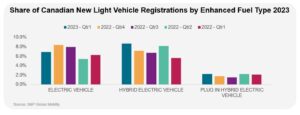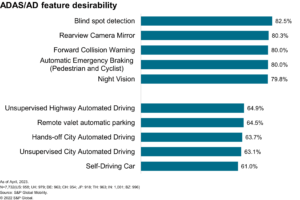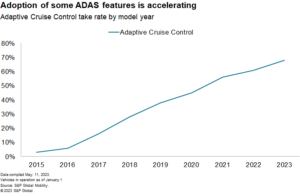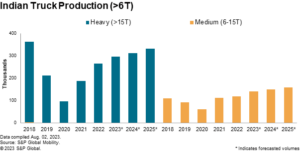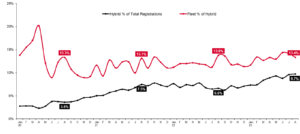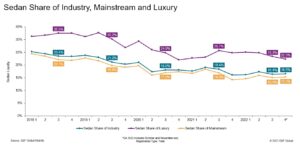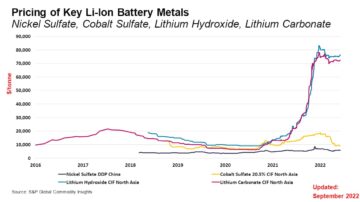Auto demand levels expected to continue tapering from 2Q
results
On an unadjusted volume level, November US light vehicle sales
are expected to advance mildly from the strike impacted levels of
October but remain absent of any momentum. S&P Global Mobility
projects sales volume of 1.23 million units for November, which
would translate to a seasonally adjusted sales rate (SAAR) of 15.5
million units for the month, even with the month-prior level.
“While the end of the UAW strikes provides some potential relief
to those automakers impacted, the ever-present affordability
concerns remain prevalent for the foreseeable future,” reports
Chris Hopson, principal analyst at S&P Global Mobility. “Over
the course of the next few months, it’s difficult to imagine auto
sales getting a jump start from the current pace of demand, with
the upshot being a bounce in early 2024 production creating a
progression for inventory and incentive levels to develop come
spring of 2024.”
New vehicle retail advertised
inventory listings peaked in mid-October just shy of 2.5
million units and have seen a slight decrease since then – from an
end-of-October level of 2.35 million units to about 2.3 million in
mid-November.
“As of mid-October, there was still more advertised dealer
inventory of outgoing 2023 model year models than incoming 2024s,
and the 2024 model year inventory was growing at a faster rate than
the 2023 model year sell-down,” said Matt Trommer, associate
director of Market Reporting at S&P Global Mobility. “But as of
mid-November, that tide seems to have reversed; there are now fewer
2023s (about 955,000 units) than 2024s (about 1.34 million).”


Continued development of battery-electric vehicle (BEV) sales
remains an assumption in the longer term S&P Global Mobility
light vehicle sales forecast. In the immediate term, some
month-to-month volatility is anticipated. October 2023 BEV share is
expected to reach 7.8%, similar to the month prior reading and
pushing year-to-date BEV sales growth to an estimated 47%. BEV
programs previously expected for stronger launches in Q4 2023 have
been delayed to 2024, creating opportunity for BEV share advances
beginning early next year.
Electric vehicle retail advertised inventories (not including
Tesla) also peaked in mid-October at 135,000 units and have
declined slightly since then. Most BEV nameplates have reached an
inventory plateau and flattened off.

This article was published by S&P Global Mobility and not by S&P Global Ratings, which is a separately managed division of S&P Global.
- SEO Powered Content & PR Distribution. Get Amplified Today.
- PlatoData.Network Vertical Generative Ai. Empower Yourself. Access Here.
- PlatoAiStream. Web3 Intelligence. Knowledge Amplified. Access Here.
- PlatoESG. Carbon, CleanTech, Energy, Environment, Solar, Waste Management. Access Here.
- PlatoHealth. Biotech and Clinical Trials Intelligence. Access Here.
- Source: http://www.spglobal.com/mobility/en/research-analysis/november-us-auto-sales-stay-the-course.html
- :is
- :not
- ][p
- 000
- 1
- 15%
- 2023
- 2024
- 23
- 250
- 35%
- 7
- 700
- a
- About
- absent
- Adjusted
- advance
- advances
- also
- an
- analyst
- and
- Anticipated
- any
- ARE
- article
- AS
- Associate
- assumption
- At
- auto
- automakers
- been
- Beginning
- being
- Bounce
- but
- by
- Chris
- come
- Concerns
- continue
- course
- Creating
- Current
- dealer
- decrease
- Delayed
- Demand
- develop
- Development
- difficult
- Director
- Division
- Early
- end
- estimated
- Ether (ETH)
- Even
- expected
- faster
- few
- fewer
- For
- Forecast
- foreseeable
- from
- future
- getting
- Global
- Growing
- Growth
- Have
- HTML
- HTTPS
- imagine
- immediate
- impacted
- in
- Incentive
- Including
- Incoming
- inventory
- IT
- jpg
- jump
- just
- launches
- Level
- levels
- light
- longer
- managed
- Market
- matt
- million
- mobility
- model
- models
- Momentum
- Month
- months
- more
- most
- next
- November
- now
- october
- of
- off
- Opportunity
- over
- Pace
- plato
- Plato Data Intelligence
- PlatoData
- potential
- prevalent
- previously
- Principal
- Prior
- Production
- Programs
- progression
- Projection
- projects
- provides
- published
- Pushing
- Rate
- ratings
- reach
- reached
- Reading
- relief
- remain
- remains
- Reporting
- Reports
- retail
- s
- S&P
- S&P Global
- Said
- sales
- Sales Volume
- seems
- seen
- Share
- similar
- since
- some
- spring
- start
- stay
- Still
- strike
- Strikes
- stronger
- term
- Tesla
- than
- that
- The
- then
- There.
- those
- Tide
- to
- translate
- units
- us
- vehicle
- Volatility
- volume
- was
- which
- while
- with
- would
- year
- zephyrnet

